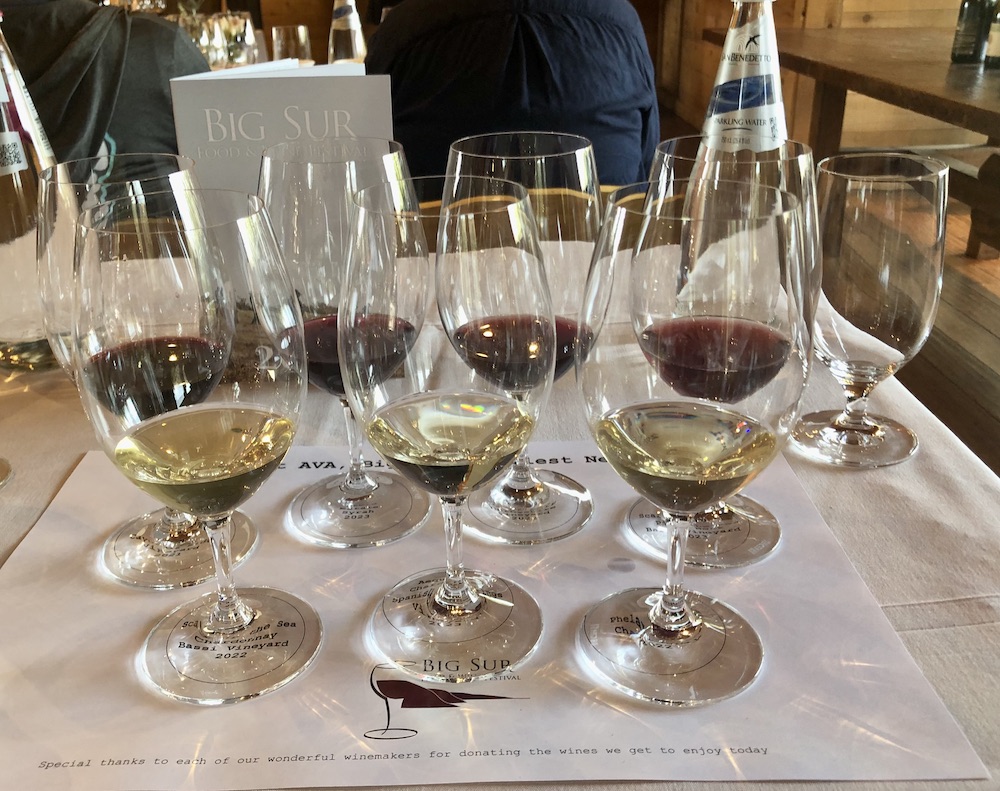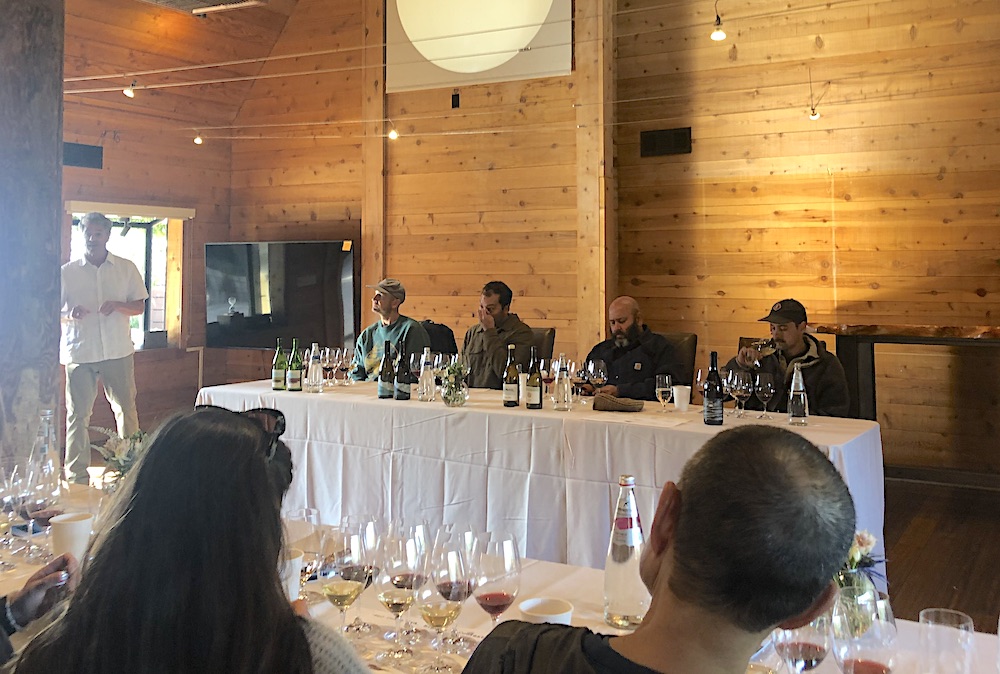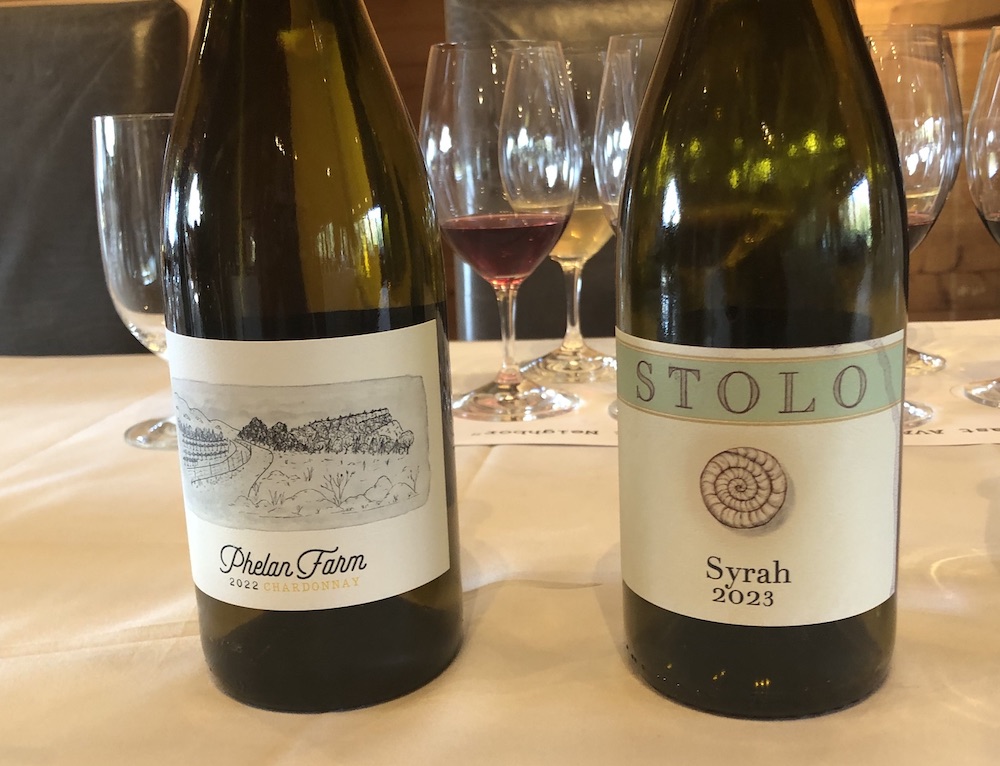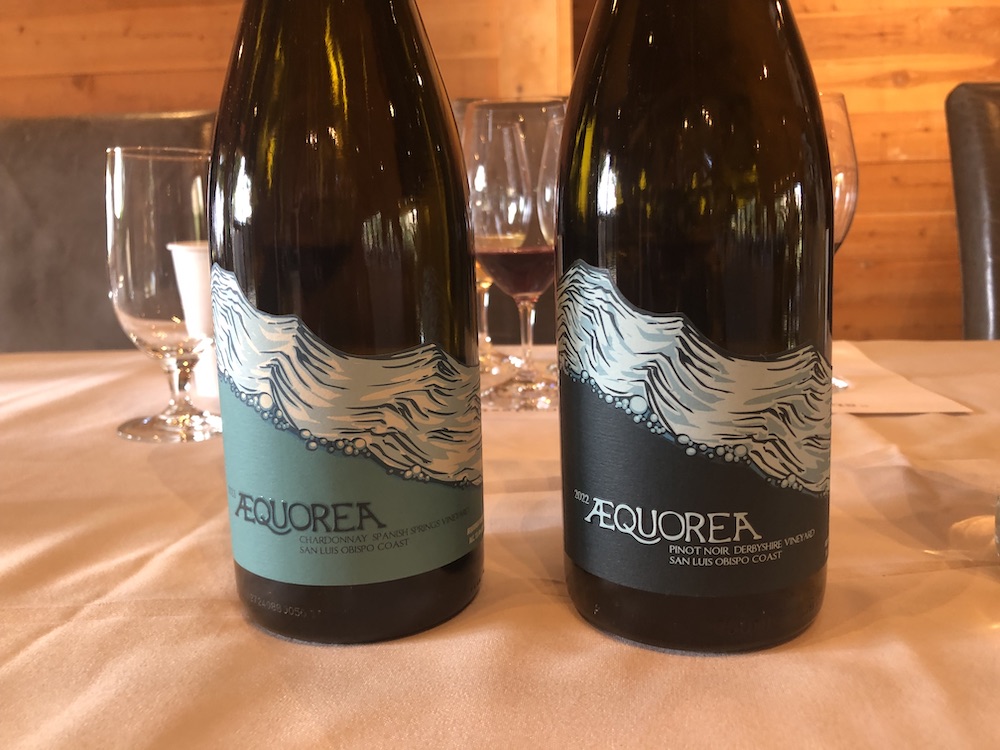
November 8, 2024 – The SLO Coast AVA was approved two years ago, giving 70-some producers who source fruit from this narrow strip of feckless opportunity that runs from San Simeon north of Cambria down to Arroyo Grande, a name to hang on their labels. Instead of San Luis Obispo County, they could now point to the ocean’s unrelenting influence as the key differentiator for their wines.
Stretching from the border of Santa Barbara County to the Monterey County Line to the north, this AVA includes all vineyards within a 15-mile swath, bordered by the Pacific Ocean and the Santa Lucia Mountains. Here in this cool climate heaven that can sometimes border on hell for a winegrower, are 78 vineyards, mostly Chardonnay and Pinot Noir, and mostly small. Excitingly for wine lovers, fun varieties like Albariño, Riesling, Gewürztraminer, Mondeuse, Grenache and Syrah, also grow here. In fact, 20% of California’s acreage of Albariño is cultivated here.
This year’s wine seminar at Big Sur Food & Wine, held the first Friday of November at Alila Ventana, was called “SLO Coast AVA; Big Sur’s Coolest Neighbor.” Four SLO Coast winemakers presented examples of vineyard designates from some of their favorite growing spots, and shared stories of heartbreak and triumph. Their wines revealed the varying degrees of success at growing grapes and making wine from California’s literally coolest new AVA.
As Big Sur Food & Wine Foundation president Aengus Wagner noted in his introductory remarks, the SLO Coast is not only Big Sur’s coolest neighbor, it’s also Big Sur’s closest neighbor, as it begins just below Ragged Point at the Monterey County line.

Apologies to the Mediterranean Sea, around which so many great wine regions are ringed, but the Pacific Ocean is the biggest heat sink on the planet, and as long as it remains so, it will be the driving factor of the fog-influenced weather we enjoy on the Central Coast. And it will also mean wines of incredibly luminosity, purity and salinity.
“When we talk about coastal vineyards, we mean very close to the ocean,” said Aaron Jackson of Aequorea Wines, a brand he created to focus strictly on these coastal gems. He founded Paso Robles-based Aaron Wines in 2002, focusing mainly on Petite Sirah, but was entranced by the inherent cool of coastal vineyards.
“These vineyards we are showcasing today are largely 2 miles or less from the ocean. Bassi Vineyard in Avila Beach is like 1.2 miles and Derbyshire up by Hearst Castle is 1.5 miles: it’s one of the most extreme sites. Cayucos Ridge is the windiest place I’ve ever been.” It’s at 1,600-1,700 feet on a steep ridgeline, 3 miles from the ocean. There’s Spanish Springs near Pismo Beach, that lies 1.5 miles from the Big Drink.
Jackson felt that having a specifically-defined AVA for truly coastal vineyards would help winemakers better tell their story, so he spearheaded the effort to get the AVA approved. Much of San Luis Obispo County is planted to vines on the benchland, where farmers can grow lots of fruit. In contrast, coastal vineyards are stingy. He got a mere 456 pounds of fruit from Derbyshire this season. That’s risky business.
“We are finding out what you can actually ripen here, Mikey Giugni of Scar of the Sea, says. “We are the second generation working in these vineyards and we are actually taking the torch and are getting to define this AVA.” He purchased Bassi Vineyard above Avila Beach in 2023 from Mike Sinor, another pioneer of the SLO Coast AVA. He notes that the ripening window here is longer, due to the ocean’s moderating influence as the autumnal equinox approaches.
“While other AVAs are hit with frost or heavy rain, which shuts down most of the AVAs, the SLO Coast still has nice, mild weather, even into mid-November,” says Giugni. “We have two seasons here. Vines can wake up with January warmth because there is no deep dormancy.”

Jackson says he picks when the last glimmer of green on the rachis is gone. “When the terminus turns brown, that means no more sugar accumulation can occur.”
Winegrower and internationally known wine expert Raj Parr, who owns Stolo Vineyards and Phelan Farm in Cambria, said he still had Syrah hanging in early November. He has been trying, not always successfully, to rehab the vineyard at Phelan Farm, planting French grapes from the Jura and the Savoie, like Savagnin, Mencia and Trousseau.
His organic methods of mildew abatement include spraying milk and turmeric on the grapes. “The good news is that we have slow sugar accumulation,” says Parr. “The bad news is there is very high mildew pressure.” He had just picked Mondeuse at its ripest ever, three days earlier. It will net out to 11% alcohol.
The very nature of the Nature’s influence here dictates a different approach to winemaking. Of his 2022 Bassi Vineyard Chardonnay, Clone 4, planted in 2001 in marine soils, Giugni says, “I love acidity, and the fruit holds it well. I need to barrel-age it for a long time, not for the oak flavors, but to add opulence, along with the tons of natural energy from the site.” He keeps the wine in barrel for 20 months, over two winters, without SO2 additions and without racking, to add texture and weight. It was picked at 19 Brix and nets to 12% alcohol.
Of the 30-acre Bassi vineyard, which he and his wife Gina have been working since 2019, Giugni says, “It has amazing bones and now we get to put our own stamp on it. We have the best years of our lives ahead of us and we’ll move towards regenerative farming, adding hedgerows for pollinators and wildlife corridors and habitats. We want to respect the amazing environment that surrounds us.”

Jackson introduced his Spanish Springs Chardonnay by confessing that being born and raised in Cayucos, his interest in SLO Coast vineyards was purely for Pinot Noir. Yet here he was.
“I didn’t want to make Chardonnay. It was an incredibly humbling experience to make the style I wanted. I’m a big fan of Chablis and White Burgundy, but I can’t afford it! I was going for candied lemon and kept getting tropical flavors. It was going to pineapple too fast. I started talking to Mikey and Oregon winemakers, and they all said, ‘pick earlier.’ So, I went out on a limb.”
That limb proved worth the stretch. He picked the 2023 Spanish Springs Chardonnay, clone 76, at 21.8Brix, barrel-fermented and inoculated, and aged it in 25% new French oak, with no SO2, and absolutely no lees stirring. “I like dissolved CO2 in the wine and intentionally keep it in the coldest part of the cellar.” He was going to age it longer, but liked it so much, he decided to bottle it with those fresh flavors. “I used to do battonage, but I stopped. Keeping the oxygen out is key.”
Of his 2022 Phelan Farm Chardonnay, Raj Parr says his compass was Burgundy. When he took over the farm, which dates to 1855, and was planted, own-rooted in 2007 to Chardonnay and Pinot Noir, in 2020, he introduced chickens and sheep.
“I read [Rudolf] Steiner and other farming books, planted cover crops and adopted no till. We experienced lots of failures.” He got very little crop in 2021 and 2022. The wine was aged in Stockinger puncheons for 12 months, settled in tank and then bottled. It has no added sulfur ever.
“Captured CO2 is key to keeping Phelan Farms wines fresh. It’s a prize to have captured CO2.” He seeks to have the imprint of the vineyard be larger than the imprint of the winemaker. “If I’m going to push it, I do it more in the vineyard than in the cellar. The final product is always in process.”

2022 Scar of the Sea Bassi Vineyard Chardonnay – Aromas of lemon and orange zest. Awesome texture, with pineapple and mango, orange bitters. Opens up forever with its lushness and rewards with lemon pudding and a sense of richness that seems impossible.
2023 Aequorea Spanish Springs Chardonnay – Bright lemon pie aromas are divine. Flavors evolve from lemon pudding to a touch of marshmallow, with exciting electricity throughout, that can best be described as lemon pop rocks.
2022 Phelan Farm Chardonnay – Cider and Bosc pear on the nose, with flavors of bright lime and starfruit on the suede-like texture that has a touch of lanolin. Constantly evolving.
These wines are compelling examples of what winemakers can do with a bit of occasional cooperation from Mother Nature. The Pinot Noirs may be even more evocative, and challenging. Jackson says that sorting this year’s crop was absolutely depressing. “I’d throw out anything I would not want to put in my mouth. We weren’t left with much.”
The key question is: “Does any of this pencil out?” asked Giugni. “Some years not. But we have a pioneering spirit.”
Good thing they are all in this together, helping each other when they can.
“Wine is about community,” says Giugni. “There is room for all of us. A key part is keeping the right attitude.”
“The SLO coast breeds tough farmers,” adds Aaron Jackson. “The AVA sticks it to you.”
And the wines reflect that toughness. “These wines taste best on the third day,” says Giugni. “They have so much energy. The AVA aligns to our style.”
About the author
Laura Ness is a longtime wine journalist, columnist and judge who contributes regularly to Edible Monterey Bay, Spirited, WineOh.Tv, Los Gatos Magazine and Wine Industry Network, and a variety of consumer publications. Her passion is telling stories about the intriguing characters who inhabit the fascinating world of wine and food.
- Laura Nesshttps://www.ediblemontereybay.com/author/lness/
- Laura Nesshttps://www.ediblemontereybay.com/author/lness/
- Laura Nesshttps://www.ediblemontereybay.com/author/lness/
- Laura Nesshttps://www.ediblemontereybay.com/author/lness/


